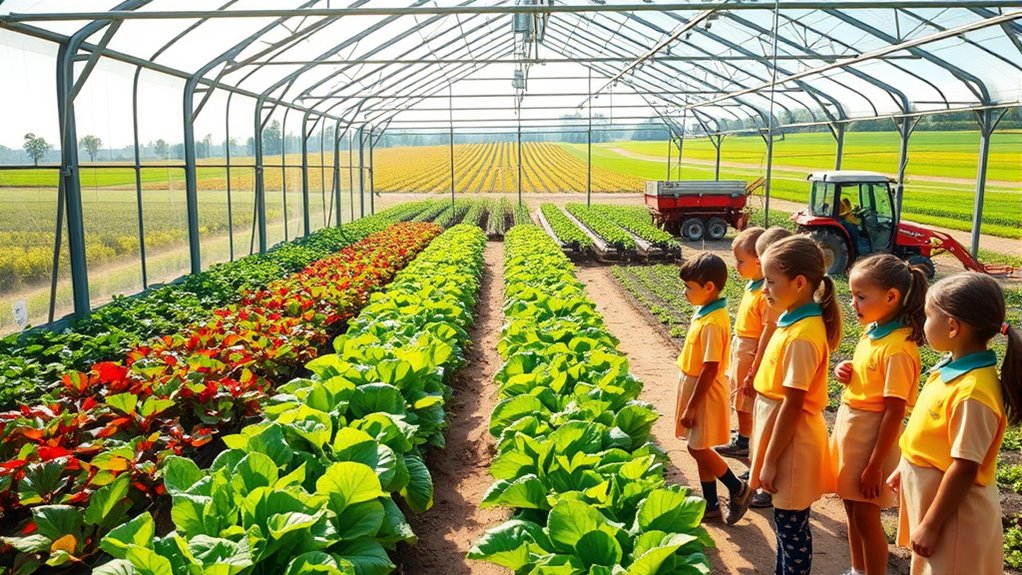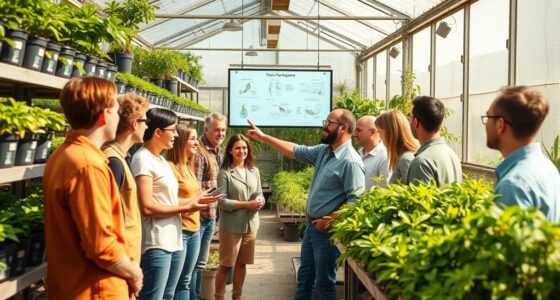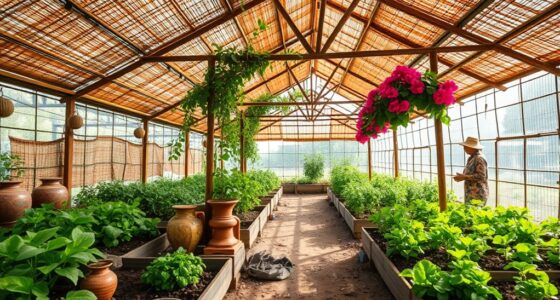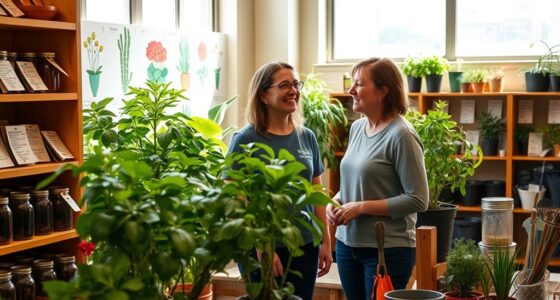School-to-farm partnerships using greenhouses create interactive learning spaces where students gain hands-on experience in sustainable farming, environmental responsibility, and food production. You’ll see students actively involved in planting, monitoring, and problem-solving, which helps develop teamwork and critical thinking skills. These programs also connect students with local farms and communities, fostering a deeper understanding of food systems and sustainability. Keep exploring to discover how these partnerships can transform education and community involvement.
Key Takeaways
- Greenhouse programs facilitate hands-on agricultural learning, fostering school-to-farm connections and real-world sustainability understanding.
- They enable students to collaborate with local farms, applying sustainable practices and improving resource efficiency.
- Greenhouses serve as a platform for educational events like farm visits, hackathons, and workshops promoting farm partnerships.
- These initiatives promote community engagement by linking schools, farms, and local food systems through shared projects.
- School-to-farm collaborations using greenhouses inspire student innovation, responsibility, and careers in agriculture and environmental stewardship.
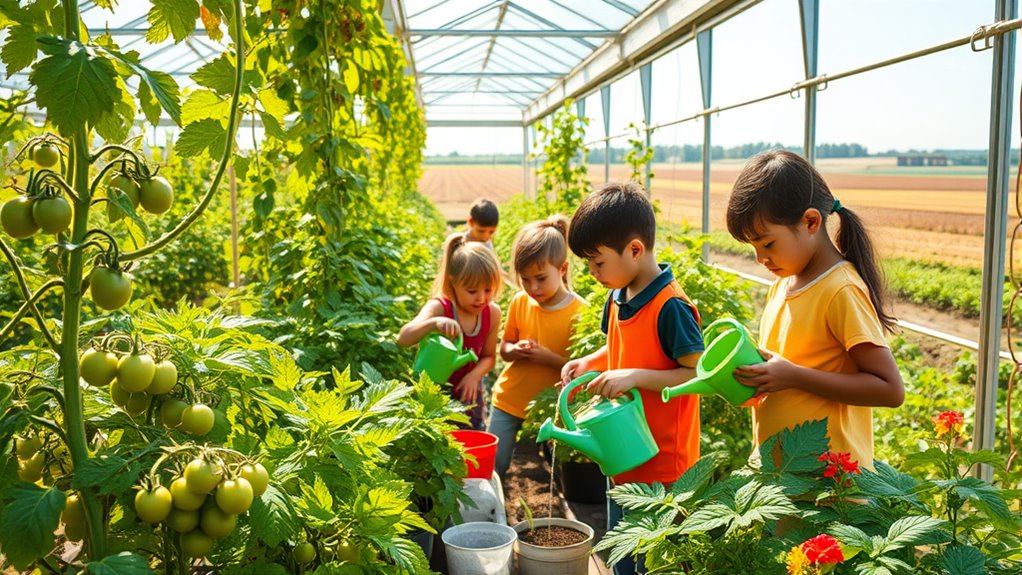
Connecting schools directly with local farms through greenhouse programs offers a hands-on way for students to learn about agriculture, sustainability, and healthy eating. By integrating greenhouses into educational settings, you can create a dynamic environment where students actively participate in growing food, gaining firsthand experience with sustainable agriculture practices. This approach not only makes learning more engaging but also instills a deeper understanding of environmental responsibility. When students see how their efforts affect real plant growth and harvest, their engagement naturally increases, fostering a sense of ownership and pride in their work.
Connecting schools with local farms through greenhouse programs fosters hands-on learning and environmental responsibility.
Greenhouse programs serve as a bridge between the classroom and the farm, allowing students to observe the principles of sustainable agriculture in action. You can teach them about soil health, water conservation, composting, and integrated pest management—core components of sustainable farming. As students tend to plants, they grasp the importance of resource efficiency and eco-friendly practices, which are *essential* for ensuring food security and environmental health. These lessons, delivered through hands-on activities, make complex concepts accessible and memorable, encouraging students to think critically about the future of food production.
Moreover, involving students directly in greenhouse operations boosts their motivation and curiosity. Instead of passive learning, they become active participants, making decisions about planting schedules, monitoring growth, and troubleshooting issues. This active engagement helps develop skills like teamwork, responsibility, and problem-solving. You’ll notice that students are more likely to ask questions, share ideas, and take initiative when they see tangible results from their efforts. This heightened engagement can inspire some students to pursue careers in agriculture, environmental science, or related fields, strengthening the pipeline of future sustainability advocates.
A greenhouse program also promotes a sense of community and collaboration. Students work together to care for plants, share responsibilities, and celebrate harvests. This collective effort emphasizes the importance of sustainable agriculture not just for individual growth but for the greater good of society. It encourages a mindset that values cooperation, resourcefulness, and local food systems. As they learn about the journey from farm to table, students gain a greater appreciation for supporting local farmers and promoting eco-friendly practices, aligning their interests with sustainable development goals. Incorporating hackathons into these programs can further inspire innovative solutions to agricultural challenges, fostering creativity and collaboration among students.
Frequently Asked Questions
How Do Greenhouses Impact Local Biodiversity?
Greenhouses can affect local biodiversity by attracting native pollinators, which benefits nearby ecosystems. However, if invasive species are introduced through greenhouse plants or materials, they may outcompete native species and disrupt local habitats. You should monitor greenhouse plants carefully, ensuring they support native pollinators while preventing invasive species from spreading. This balance helps protect local biodiversity and maintains healthy ecosystems around your farm or school project.
What Funding Options Are Available for School Greenhouse Projects?
You can explore grant opportunities from local government agencies, non-profits, or educational foundations to fund your school greenhouse project. Crowdfunding options like GoFundMe or DonorsChoose also work well, allowing you to raise funds directly from your community. Be sure to prepare a compelling proposal or campaign that highlights the educational benefits and community impact. Combining these funding sources maximizes your chances of successfully establishing and maintaining your greenhouse.
How Can Partnerships Be Sustained Long-Term?
You can sustain partnerships long-term by actively fostering community engagement and integrating greenhouses into your curriculum. Regular communication with partners keeps everyone invested, while involving students and local groups builds a sense of shared purpose. Incorporate greenhouse activities into lessons, events, and community projects to demonstrate ongoing value. This continuous engagement and curriculum integration help solidify relationships, ensuring your school-to-farm partnership remains strong and sustainable over time.
What Safety Measures Are Necessary for Student Involvement?
You need to prioritize student safety by enforcing strict greenhouse protocols, such as wearing protective gear, handling tools properly, and following clear instructions. Make sure students are trained on emergency procedures and understand the importance of hygiene and safety rules. Regularly inspect equipment and the greenhouse environment for hazards. Supervising staff should be vigilant and reinforce safety practices consistently, ensuring a secure learning space for every student involved.
How Do Greenhouses Contribute to Curriculum Development?
Imagine a lush haven where curiosity blossoms—greenhouses. You can see how they contribute to curriculum development by immersing students in urban agriculture and plant science. These spaces allow hands-on learning, fostering understanding of sustainable farming and ecological systems. They inspire creativity and critical thinking, linking classroom concepts to real-world applications. Through greenhouses, you create vibrant educational experiences that cultivate knowledge, passion, and a deeper connection to the environment.
Conclusion
By embracing school-to-farm partnerships with greenhouses, you gently nurture young minds and healthy futures. These collaborations quietly sow seeds of knowledge and responsibility, helping students grow into thoughtful stewards of the land. As you continue fostering these connections, you’ll find that the benefits blossom naturally—creating a more sustainable and educated community. With patience and care, you’re guiding a brighter tomorrow, one greenhouse at a time.
